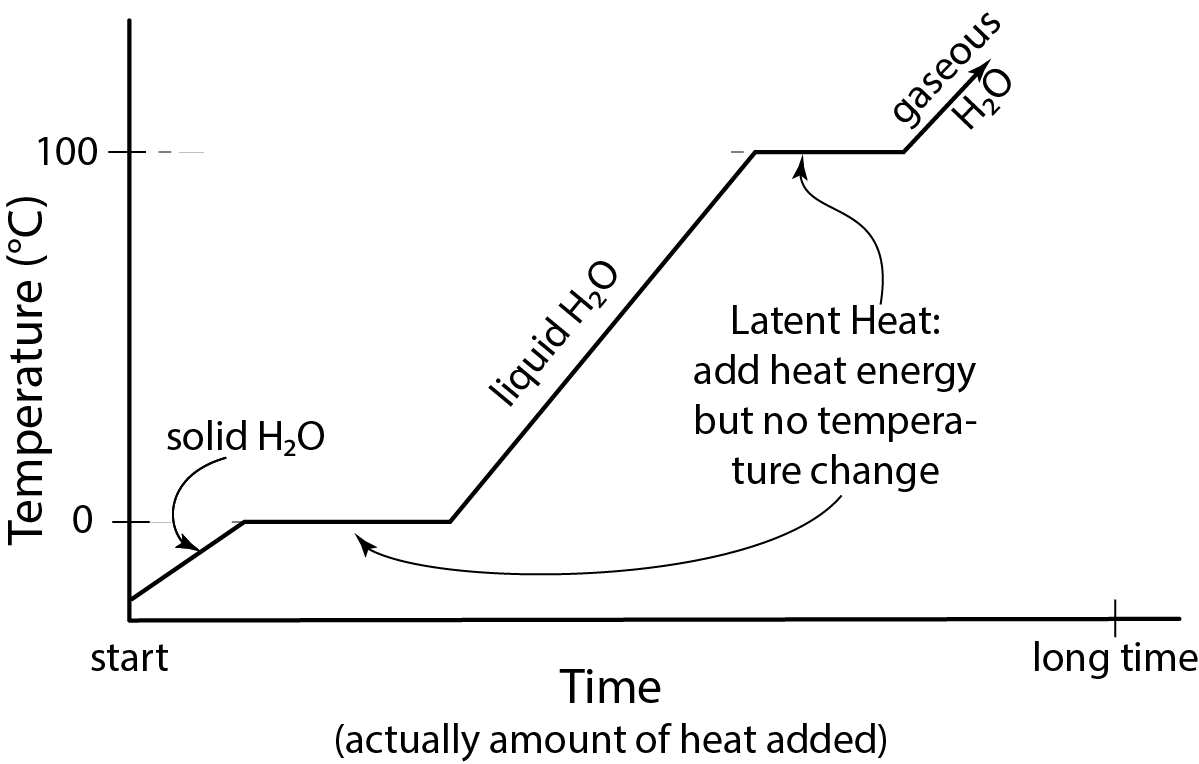1 The Atmosphere and Energy
Goals and objectives of this chapter:
- Understand the significance of the atmosphere.
- Describe the composition of the atmospheric gasses.
- Explain the major layers of the atmosphere and their importance.
- Analyze the relationships between energy, temperature, and heat.
- Describe how the Sun influences seasonality.
- Describe how heat is transferred around the planet.
Earth’s atmosphere is a thin blanket of gases and tiny particles — together called air. We are most aware of air when it moves and creates wind. All living things need some of the gases in air for life support. Without an atmosphere, Earth would likely be just another lifeless rock. Earth’s atmosphere, along with the abundant liquid water at Earth’s surface, are the keys to our planet’s unique place in the solar system. Much of what makes Earth exceptional depends on the atmosphere. Let’s consider some of the reasons we are lucky to have an atmosphere.
INTERACTION WITH SOLAR ENERGY
The diversity of earth’s surface is due to different concentrations of energy. The atmosphere is the location of the first interaction of solar energy with the earth. About 40% of the earth’s total energy comes from the sun, the rest comes from within the earth. The atmosphere is key for distribution and redistribution of this solar energy.
INDISPENSABLE FOR LIFE ON EARTH
 Without the atmosphere, Earth would look a lot more like the Moon. Atmospheric gases, especially carbon dioxide (CO2) and oxygen (O2), are extremely important for living organisms. How does the atmosphere make life possible? How does life alter the atmosphere?
Without the atmosphere, Earth would look a lot more like the Moon. Atmospheric gases, especially carbon dioxide (CO2) and oxygen (O2), are extremely important for living organisms. How does the atmosphere make life possible? How does life alter the atmosphere?
In photosynthesis plants use CO2 and create O2. Photosynthesis is responsible for nearly all of the oxygen currently found in the atmosphere. By creating oxygen and food, plants have made an environment that is favorable for animals. In respiration, animals use oxygen to convert sugar into food energy they can use. Plants also go through respiration and consume some of the sugars they produce.
CRUCIAL PART OF THE WATER CYCLE
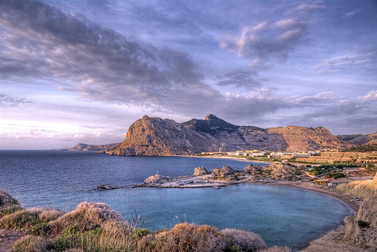 As part of the hydrologic cycle, water spends a lot of time in the atmosphere, mostly as water vapor. All weather takes place in the atmosphere, virtually all of it in the lower atmosphere. Weather describes what the atmosphere is like at a specific time and place, and may include temperature, wind, and precipitation. Weather is the change we experience from day to day. Climate is the long-term average of weather in a particular spot. Although the weather for a particular winter day in Tucson, Arizona, may include snow, the climate of Tucson is generally warm and dry.
As part of the hydrologic cycle, water spends a lot of time in the atmosphere, mostly as water vapor. All weather takes place in the atmosphere, virtually all of it in the lower atmosphere. Weather describes what the atmosphere is like at a specific time and place, and may include temperature, wind, and precipitation. Weather is the change we experience from day to day. Climate is the long-term average of weather in a particular spot. Although the weather for a particular winter day in Tucson, Arizona, may include snow, the climate of Tucson is generally warm and dry.
MODERATES EARTH’S TEMPERATURE
Along with the oceans, the atmosphere keeps Earth’s temperatures within an acceptable range. Greenhouse gases trap heat in the atmosphere so they help to moderate global temperatures. Without an atmosphere with greenhouse gases, Earth’s temperatures would be frigid at night and scorching during the day. Important greenhouse gases include carbon dioxide, methane, water vapor, and ozone.
Energy, Temperature, and Heat
ENERGY
Energy travels through space or material. This is obvious when you stand near a fire and feel its warmth or when you pick up the handle of a metal pot even though the handle is not sitting directly on the hot stove. Invisible energy waves can travel through air, glass, and even the vacuum of outer space. These waves have electrical and magnetic properties, so they are called electromagnetic waves. The transfer of energy from one object to another through electromagnetic waves is known as radiation. Different wavelengths of energy create different types of electromagnetic waves.
- The wavelengths humans can see are known as “visible light.” These wavelengths appear to us as the colors of the rainbow. What objects can you think of that radiate visible light? Two include the sun and a light bulb.
- The longest wavelengths of visible light appear red. Infrared wavelengths are longer than visible red. Snakes can see infrared energy. We feel infrared energy as heat.
- Wavelengths that are shorter than violet are called ultraviolet.
Can you think of some objects that appear to radiate visible light, but actually do not? The moon and the planets do not emit light of their own; they reflect the light of the sun. Reflection is when light (or another wave) bounces back from a surface. Albedo is a measure of how well a surface reflects light. A surface with high albedo reflects a large percentage of light. A snow field has high albedo.
One important fact to remember is that energy cannot be created or destroyed — it can only be changed from one form to another. This is such a fundamental fact of nature that it is a law: the law of conservation of energy.
In photosynthesis, for example, plants convert solar energy into chemical energy that they can use. They do not create new energy. When energy is transformed, some nearly always becomes heat. Heat transfers between materials easily, from warmer objects to cooler ones. If no more heat is added, eventually all of a material will reach the same temperature.
ENERGY MOVEMENT
Energy moves in one of three methods: convection, conduction, radiation. As mentioned above, radiant energy can move through a vacuum, with no molecular mass present. That’s how energy moves from the sun to Earth.
Energy within some mass can move adjacent, touching, mass via conduction. The masses must be in contact with each other. The energy moves from the warmer mass, with more energy, to the cooler mass. The masses themselves don’t change location. Electric wires move energy via conduction. The energy moves from molecule to molecule, but the wires stay in place. A warm earth or ocean can warm the air molecules touching the ground or water via conduction.
In fluids, including both liquids and gasses, energized molecules can move to a new location, bringing the heat energy with the molecule to the new location. This is convection. The molecules move, keeping the heat energy with them. Again, energy is moving from high concentration (hot) to low concentration (cool).
TEMPERATURE
Temperature is a measure of how fast the atoms in a material are vibrating. High temperature particles vibrate faster than low temperature particles. Rapidly vibrating atoms smash together, which generates heat. As a material cools down, the atoms vibrate more slowly and collide less frequently. As a result, they emit less heat. What is the difference between heat and temperature?
- Temperature measures how fast a material’s atoms are vibrating.
- Heat measures the material’s total energy.
Which has higher heat and which has higher temperature: a candle flame or a bathtub full of hot water?
- The flame has higher temperature, but less heat, because the hot region is very small.
- The bathtub has lower temperature but contains much more heat because it has many more vibrating atoms. The bathtub has greater total energy.
HEAT
Heat is taken in or released when an object changes state, or changes from a gas to a liquid, or a liquid to a solid. This heat is called latent heat. When a substance changes state, latent heat is released or absorbed. A substance that is changing its state of matter does not change temperature. All of the energy that is released or absorbed goes toward changing the material’s state.
For example, imagine a pot of boiling water on a stove burner: that water is at 100°C (212°F). If you increase the temperature of the burner, more heat enters the water. The water remains at its boiling temperature, but the additional energy goes into changing the water from liquid to gas. With more heat the water evaporates more rapidly. When water changes from a liquid to a gas it takes in heat. Since evaporation takes in heat, this is called evaporative cooling. Evaporative cooling is an inexpensive way to cool homes in hot, dry areas.
Humid air masses transport not just the water molecules but also the energy required to evaporate those air molecules. The energy required to evaporate 1 g of water already at 100°C to gaseous vapor at 100°C is 540 calories. When that gaseous water condenses to liquid water, it releases 540 cal of energy to the immediate surroundings. For liquid water to freeze, it must release 80 cal. Solid ice must gain 80cal to melt. Then definition of a calorie of energy is the amount of energy required to raise the temperature of 1g water by 1°C from 3.5° to 4.5°C at standard air pressure. It is equivalent to 4.184 Joules of energy.
Substances also differ in their specific heat, the amount of energy needed to raise the temperature of one gram of the material by 1.0°C (1.8°F). Water has a very high specific heat, which means it takes a lot of energy to change the temperature of water. Let’s compare a puddle and asphalt, for example. If you are walking barefoot on a sunny day, which would you rather walk across, the shallow puddle or an asphalt parking lot? Because of its high specific heat, the water stays cooler than the asphalt, even though it receives the same amount of solar radiation.
SOLAR RADIATION AND EARTH
The Earth constantly tries to maintain an energy balance with the atmosphere. Most of the energy that reaches the Earth’s surface comes from the sun. About 44% of solar radiation is in the visible light wavelengths, but the sun also emits infrared, ultraviolet, and other wavelengths. When viewed together, all of the wavelengths of visible light appear white. But a prism or water droplets can break the white light into different wavelengths so that separate colors appear. Of the solar energy that reaches the outer atmosphere, UV wavelengths have the greatest energy. Only about 7% of solar radiation is in the UV wavelengths. The three types are:
- UVC: the highest energy ultraviolet, does not reach the planet’s surface at all.
- UVB: the second highest energy, is also mostly stopped in the atmosphere.
- UVA: the lowest energy, travels through the atmosphere to the ground.
The remaining solar radiation is the longest wavelength, infrared. Most objects radiate infrared energy, which we feel as heat. Some of the wavelengths of solar radiation traveling through the atmosphere may be lost because they are absorbed by various gases. Ozone completely removes UVC, most UVB and some UVA from incoming sunlight. Oxygen, carbon dioxide, and water vapor also filter out some wavelengths.
UNEVEN DISTRIBUTION OF SOLAR ENERGY
Different regions of the Earth receive different amounts solar radiation. This is because of the angle of incidence, the angle of the sun above the horizon, not because of distance from the sun. When the sun is low on the horizon, the solar energy is spread out over a larger area of the earth’s surface. Less solar energy arrives at each 1m2 near the poles compared to 1m2 near the equator. Also, at such low angle of incidence, the sunlight must pass through a greater thickness of the atmosphere so there’s a greater chance that the the atmosphere will reflect light before it reaches the earth’s surface. In the image the yellow circle in central North America is larger indicating radiation over a larger area, but the yellow is more transparent indicating less energy per unit area compared to the circle over Florida.
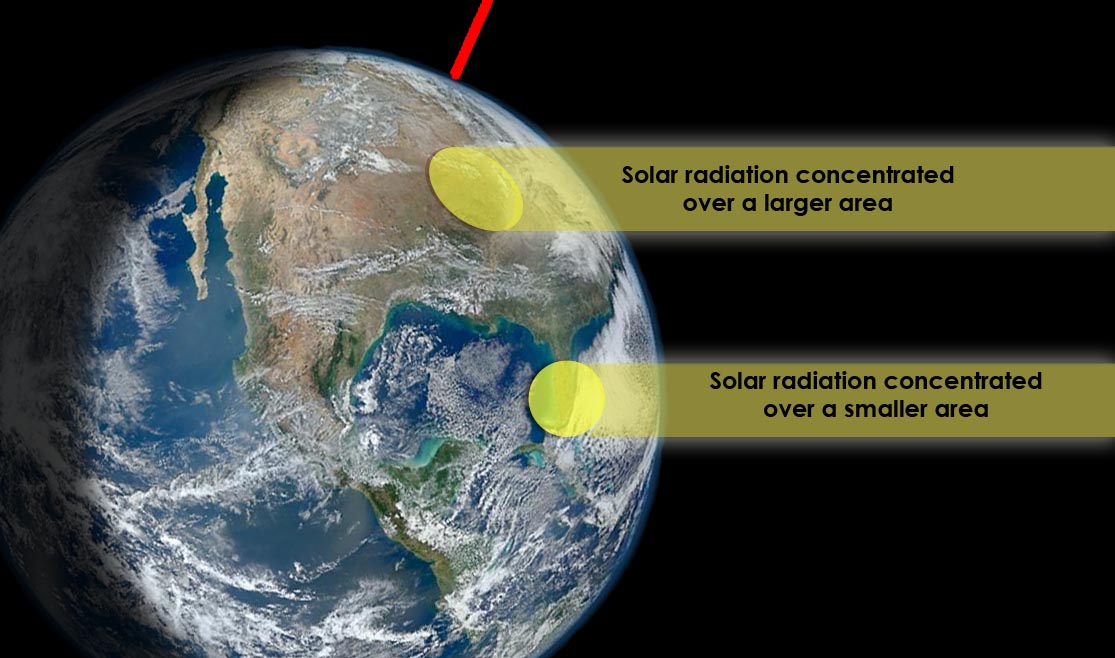

Regions from about 40°N to 40°S receive a surplus of energy which moves towards the poles which receive a deficit of solar energy.
Different region also receive different amounts of sunlight depending on the seasons. The seasons are caused by the direction Earth’s axis is pointing relative to the sun. The Earth revolves around the sun once each year and spins on its axis of rotation once each day. This axis of rotation is tilted 23.5 degrees relative to its plane of orbit around the sun. The axis of rotation is pointed toward Polaris, the North Star. As the Earth orbits the sun, the tilt of Earth’s axis stays lined up with the North Star.
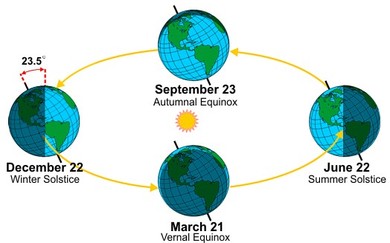
PARALLELISM
Wherever the earth is located during it’s revolution around the the sun, it’s axis is always parallel to it’s axis at any other location in the orbit. That means sometimes the north pole is pointed towards the sun, sometimes the north pole is pointed away from the sun. If parallelism didn’t happen, then one pole would always be pointed toward the sun and the other pole would never receive any sunlight. There would be no seasons. There would be a greater difference in energy from the coldest pole to the hottest latitude with direct sunlight.
NORTHERN HEMISPHERE SUMMER
The North Pole is tilted towards the sun and the sun’s rays strike the Northern Hemisphere more directly in summer. At the summer solstice, June 21 or 22, the sun’s rays hit the Earth most directly along the Tropic of Cancer (23.5°N); that is, the angle of incidence of the sun’s rays there is zero (the angle of incidence is the deviation in the angle of an incoming ray from straight on). On the day of the summer solstice in the Northern Hemisphere, it is the winter solstice in the southern Hemisphere.
NORTHERN HEMISPHERE WINTER
Winter solstice for the Northern Hemisphere happens on December 21 or 22. The tilt of the North Pole points away from the sun. Light from the sun is spread out over a larger area in the northern hemisphere, but is more concentrated in the southern hemisphere. With fewer daylight hours in winter, there is also less time for the sun to warm the area. When it is winter in the Northern Hemisphere, it is summer in the Southern Hemisphere.
EQUINOX
Halfway between the two solstices, the sun’s rays shine most directly at the equator, called an “equinox.” The autumnal equinox happens on September 22 or 23 and the vernal or spring equinox happens March 21 or 22 in the Northern Hemisphere. Remember the equator is equidistant between the poles and the sun is over the equator on the equinox.
Heat Transfer in the Atmosphere
Heat moves in the atmosphere the same way it moves through the solid Earth or another medium. What follows is a review of the way heat flows and is transferred, but applied to the atmosphere. Radiation is the transfer of energy between two objects by electromagnetic waves. Energy from the sun moves to the earth via radiation. Heat radiates from the ground into the lower atmosphere.
In conduction, heat moves from areas of more heat to areas of less heat by direct contact. Warmer molecules vibrate rapidly and collide with other nearby molecules, transferring their energy from one molecule to a different molecule. In the atmosphere, conduction is more effective at lower altitudes where air density is higher; transfers heat upward to where the molecules are spread further apart or transfers heat laterally from a warmer to a cooler spot, where the molecules are moving less vigorously.
Heat transfer by movement of heated materials is called convection. Heat that radiates from the ground initiates convection cells in the atmosphere. Warm air molecules move to an area with less heat, bringing the heat energy with them.
HEAT AT EARTH’S SURFACE
About half of the solar radiation that strikes the top of the atmosphere is filtered out before it reaches the ground. This energy can be absorbed by atmospheric gases, reflected by clouds, or scattered. Scattering occurs when a light wave strikes a particle and bounces off in some other direction.
About 3% of the energy that strikes the ground is reflected back into the atmosphere. The rest is absorbed by rocks, soil, and water and then radiated back into the air as heat. These infrared wavelengths can only be seen by infrared sensors. Because solar energy continually enters Earth’s atmosphere and ground surface, is the planet getting hotter? The answer is no (although the next section contains an exception) because energy from Earth escapes into space through the top of the atmosphere. If the amount that exits is equal to the amount that comes in, then average global temperature stays the same. This means that the planet’s heat budget is in balance. What happens if more energy comes in than goes out? If more energy goes out than comes in?
To say that the Earth’s heat budget is balanced ignores an important point. The amount of incoming solar energy is different at different latitudes). Where do you think the most solar energy ends up and why? Where does the least solar energy end up and why? The difference in solar energy received at different latitudes drives atmospheric circulation.
|
Day Length
|
Sun Angle
|
Solar Radiation
|
Albedo
|
|
|
Equatorial Region
|
Nearly same all year
|
High
|
High
|
Low
|
|
Polar Regions
|
Night 6 months
|
Low
(sun always near horizon)
|
Low
(not much energy per m2)
|
High
(most is reflected)
|
EARTH’S RADIATION BUDGET
A budget identifies sources and amounts of what comes in or out of a system. In finance, you look at sources and amounts of income and for expenses. If the amount coming in is greater than the amount outgoing, then you have a net accumulation or savings. Conversely, if expenses are greater than income then you take money from savings or borrow from elsewhere.
In the earth energy budget we look at the shortwave energy coming in (100% from the sun) and where it goes. We compare that with the outgoing energy in form of both shortwave and longwave radiation. Of the insolation (incoming solar radiation) that reaches the outermost atmosphere, about half is absorbed by the Earth’s surface. The other half is either absorbed within the atmosphere or reflected back to space from the atmosphere or earth’s surface. The first image of Earth’s Energy Budget uses percentages. 100% of isolation hits the top of the atmosphere, and 100% must return to space, although it may change form from shortwave (yellow arrows) to longwave radiation (red arrows).

The diagrams below show the movement of energy as W/m2. On average, from pole to equator to pole, from January to June to December, the Earth receives 340 W/m2. Some of that energy is redirected or changes form, such as shortwave to longwave or sensible heat to latent heat. The influence of a clear sky vs a cloudy sky is significant as shown below.

CHANGING THE ENERGY BUDGET
The amount of energy coming from the sun has changed slightly in the 4.6 billions years the earth has existed. The Sun is now larger and releasing more energy. Changing the chemical composition of the atmosphere has allowed the earth’s surface temperature to remain quite stable, within about a 10°C range from warmest to coolest. However, the chemistry changes of the last 200 years have led to more energy staying in the earth system and less energy going to outer space. See later chapters about climate change for more details on this.
THE GREENHOUSE EFFECT
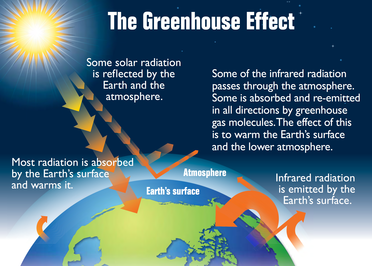
The exception to Earth’s temperature being in balance is caused by greenhouse gases. But first the role of greenhouse gases in the atmosphere must be explained. Greenhouse gases warm the atmosphere by trapping heat. Some of the heat radiation out from the ground is trapped by greenhouse gases in the troposphere. Like a blanket on a sleeping person, greenhouse gases act as insulation for the planet. The warming of the atmosphere because of insulation by greenhouse gases is called the greenhouse effect. Greenhouse gases are the component of the atmosphere that moderate Earth’s temperatures. Greenhouse gases include CO2, H2O, methane, O3, nitrous oxides (NO and NO2), and chlorofluorocarbons (CFCs). All are a normal part of the atmosphere except CFCs. The table below shows how each greenhouse gas naturally enters the atmosphere.
|
Greenhouse Gas
|
Where It Comes From
|
|
Carbon dioxide Methane Nitrous oxide Ozone Chlorofluorocarbons |
Respiration, volcanic eruptions, decomposition of plant material; burning of fossil fuels Decomposition of plant material under some conditions, biochemical reactions in stomachs Produced by bacteria Atmospheric processes Not naturally occurring; made by humans |
Different greenhouse gases have different abilities to trap heat. For example, one methane molecule traps 23 times as much heat as one CO2 molecule. One CFC-12 molecule (a type of CFC) traps 10,600 times as much heat as one CO2. Still, CO2 is a very important greenhouse gas because it is much more abundant in the atmosphere. Human activity has significantly raised the levels of many of greenhouse gases in the atmosphere. Methane levels are about 2 1/2 times higher as a result of human activity. Carbon dioxide has increased more than 35%. CFCs have only recently existed.
What do you think happens as atmospheric greenhouse gas levels increase? More greenhouse gases trap more heat and warm the atmosphere. The increase or decrease of greenhouse gases in the atmosphere affect climate and weather the world over.


